Widex CROS & BiCROS Hearing Solutions
SUPERB SOUND WITH NO ECHO
IMPROVES SPEECH INTELLIGIBILITY
Widex CROS & BiCROS hearing solutions are available in the Widex Unique and Evoke Fusion product lines.
Improving speech intelligibility
with WIDEX CROS
Increased demands on communication skills in modern society emphasize the need to recognize the detrimental effects of single sided deafness (SSD). By wirelessly transmitting sound from the deaf ear to the better ear, the new WIDEX CROS hearing aid solution reduces the head shadow effect and thereby diminishes detrimental effects. The present study demonstrates how the new WIDEX CROS improves the intelligibility of speech and enhances the ease of conversation in the many common everyday situations that are found challenging by people with SSD.
Single Sided Deafness (SSD)
People with SSD may experience several detrimental effects of not being able to hear in their deaf ear. For instance their ability to localize sound is impeded due to the lack of inter-aural level and timing differences.
The lack of stereo hearing also reduces the perceived quality of sound. The main problem however is that people with SSD have reduced speech intelligibility for several reasons: The inability to separate background noise from the signal of interest, the lack of binaural summation effect and difficulties hearing the signal of interest coming from the side of the deaf ear. As with hearing impairment in general, SSD may lead to considerable lifestyle implications. Repeatedly missing out on conversation, or finding communication especially challenging and energy consuming in particular situations, heightens the risk of withdrawal, which may affect work, family and social life. Although the above-mentioned difficulties cannot all be met through amplification, the WIDEX CROS benefits people with SSD in numerous everyday situations by transmitting sound from the deaf ear to the better ear. This could be, for example, when struggling to hear sounds that occur on the side of the deaf ear or having a conversation in a challenging environment such as a noisy room, driving in a car, in a group discussion etc.
Widex CROS & BiCROS
The new WIDEX CROS series encompasses two options of contralateral routing of signal. The CROS system is targeted at people with SSD and normal hearing in the better ear. The BiCROS system is targeted at people with SSD and some degree of hearing loss in the better ear.
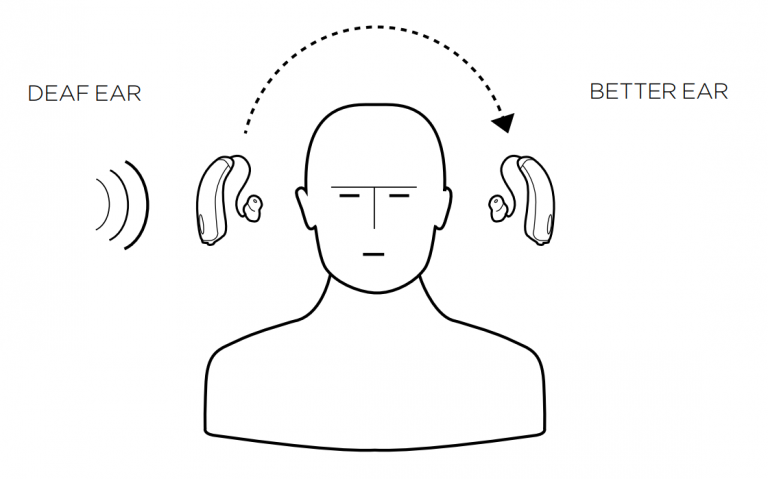
Figure 1. CROS system. The transmitter is placed behind the deaf ear. Here it picks up sound and wirelessly transmits it to the receiver hearing aid on the normal-hearing ear. Normal hearing on the better ear will not be affected.

Figure 2. BiCROS system. The transmitter is placed behind the
deaf ear. Here it detects sound and wirelessly transmits it to the
receiver hearing aid on the hearing-impaired, better ear. The receiver hearing aid also amplifies sound on the better ear, so that
it matches the degree of hearing loss in this ear.
With the WIDEX CROS, sound is transmitted wirelessly using WidexLink technology, which ensures superior sound quality free of artifacts and echo. The clear sound quality brings speech intelligibility in focus.
Improved Speech Intelligibility In Noise For People With SSD Study - WIDEX CROS Solution
The aim of the study was to objectively determine the improvement of speech intelligibility in noise for people with SSD when using the WIDEX CROS solution, and to determine in which everyday situations the WIDEX CROS proved to be most beneficial to the user.
The Hearing in Noise Test (HINT) was used to measure the effect of the WIDEX CROS on speech intelligibility in background noise. The test is adaptive, which means that the results were obtained at the performance level where the individual test subject had a 50% correct sentence identification. This allowed a comparison of scores across the different test subjects. The noise signal used was the HINT noise signal, which is an artificial speech shaped noise. The HINT was administered in a sound booth with a loudspeaker setup in which speech was presented directly from the side of the deaf ear and noise was presented from three loudspeakers on the side of the better ear.
The noise level was fixed at 65 dB SPL and the speech level was adjusted to match the signal-to-noise ratio at 50% correct sentence identification.
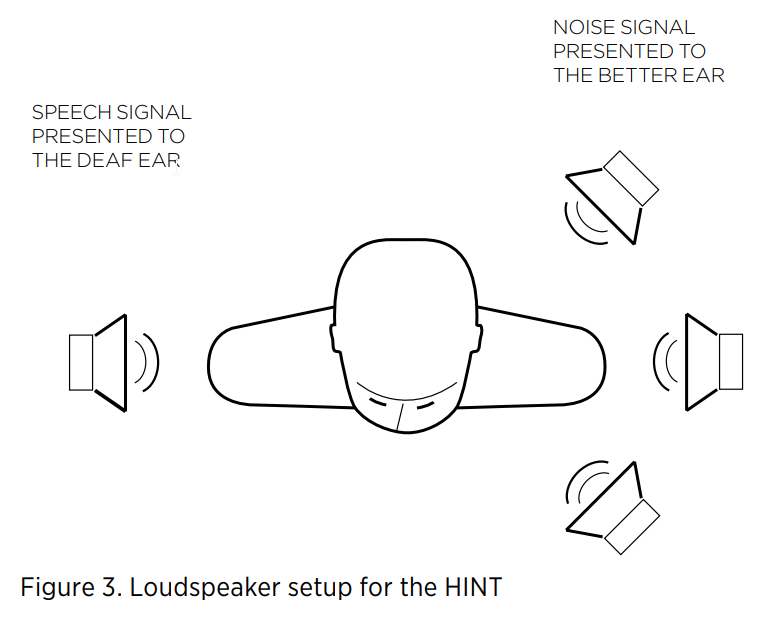
The noise level was fixed at 65 dB SPL and the speech level was adjusted to match the signal-to-noise ratio at 50% correct sentence identification.
Besides the HINT test, which scored the improvement in speech intelligibility with WIDEX CROS, each test subject was asked to fill in the Bern Benefit in Single Sided Deafness Questionnaire (BBSS). The BBSS questionnaire consists of 10 questions in which the test subjects are asked to give a subjective evaluation of how beneficial the WIDEX CROS is to them in a specific communication situation.
The test subjects wore the WIDEX CROS as an integrated part of their everyday life for an extensive trial period. The average daily use was more than 8 hours, allowing the WIDEX CROS to be thoroughly tested in many different communication situations. A total of 10 test subjects participated in the study – 5 CROS and 5 BiCROS users.
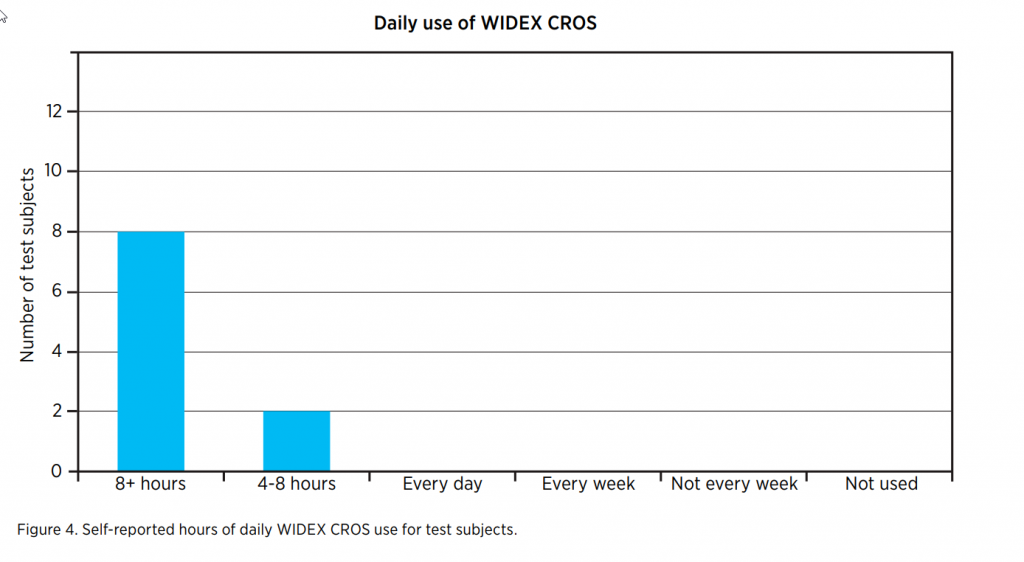
Hearing Improvement Results
The HINT test showed significant improvements of the test subjects’ speech intelligibility in noise.
In the described test setup, the CROS users demonstrated a 4.6 dB improvement in their Speech Reception Threshold (SRT) with the WIDEX CROS transmitter and receiver compared to no amplification. The BiCROS users demonstrated a 3.8 dB improvement in their SRT when they used the WIDEX CROS transmitter and receiver compared to when they only used amplification on the better (hearing-impaired) ear.
A follow-up questionnaire indicated all the test subjects perceived improvements in specific everyday communication situations with the WIDEX CROS. The test subjects rated a positive improvement when using the WIDEX CROS in nearly all of the communication situations they were asked about. Localization of a sound source did not get better or worse when using the WIDEX CROS, and understanding speech in a reverberant room was rated to be slightly more difficult.
The specific situations in which the test subjects rated the improvements with WIDEX CROS to be the most significant were when following a conversation in the presence of background noise, when having a conversation while driving a car and when participating in a group conversation. All of these common everyday situations are also known as being typical examples of the most troublesome communication situations for people with SSD. On the whole, the test subjects rated their overall hearing to be easier with the WIDEX CROS.
The new WIDEX CROS offers superior technology to help minimize the detrimental effects of SSD by wirelessly transmitting sound from the side of the deaf ear to the user’s better ear.
The objective of the presented study was to determine the improvement of speech intelligibility in noise with the WIDEX CROS and to determine specific everyday situations where the WIDEX CROS proved to be most beneficial to the user.
The results from the objective testing showed that the WIDEX CROS technology significantly improves speech intelligibility of a person with SSD when hearing in noise.
The test subjects rated communication in noisy environments or other challenging everyday situations such as driving a car or participating in a conversation with multiple talkers, such as a meeting or a social gathering, to be easier with the WIDEX CROS.
With the increased demands on communication skills in modern society many common everyday communication situations are made easier with the WIDEX CROS, allowing the user to participate without the concern of missing out on conversation.
References
Kompis M, Pfiffner F, Krebs M, Caversaccio M. Factors Influencing the Decision for Baha in Unilateral Deafness: The Bern Benefit in Single Sided Deafness questionnaire. Adv Otorhinolaryngol 71 (2011)
Nilsson, M.; Soli, S. D.; Sullivan, J. A. (1994). Development of the Hearing in Noise Test for the measurement
of speech reception thresholds in quiet and in noise.
The Journal of the Acoustical Society of America 95
(2): 1085–1099
For more information on Widex CROS or BiCROS hearing solutions, please call HearSource 1-800-416-2434, 9:00 a.m. to 9:00 p.m. Eastern Time (6:00 a.m. to 6:00 p.m. Pacific Time)

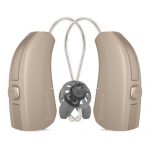
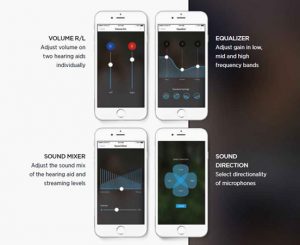



This Post Has One Comment
Widex has been offering wireless CROS technology for quite a long time and has some fairly advanced features in their systems. Widex utilizes their directional microphone features comprehensively at all four of their technology levels, so they have more economical options available. They also offer good performance in background noise. Widex also has the most comprehensive features available for tinnitus management as compared to other hearing aid manufacturers. Widex is my product of choice for my single-sided deafness.